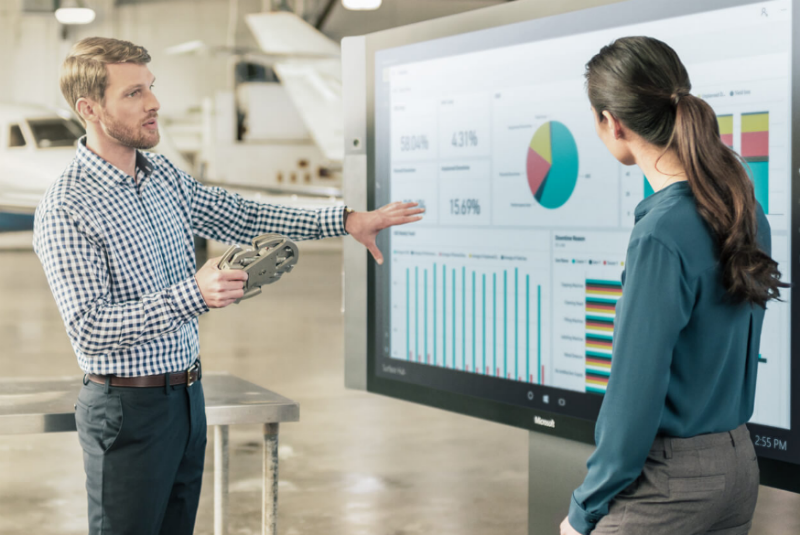 NEWS
NEWS
 NEWS
NEWS
 NEWS
NEWS
Microsoft launched the Surface Hub at the Windows 10 Preview event back in January 2015. Regardless of the fact that it was delayed twice and eventually went on sale for $2,000 more than the expected price, sales have still exceeded expectations.
The collaborative device, which starts at $8,999 for the 55 inch and $21,999 for the 84 inch, started shipping in March this year and has been purchased by more than 500 customers worldwide.
With regards to availability, Microsoft told Petri, “Demand for Surface Hubs is very strong and exceeded initial forecasts. To date, we’ve shipped to over 500 customers worldwide and that number continues to grow. We are ramping up production to meet this strong demand via our partner reseller channel as soon as possible. Customers are encouraged to speak with their sales representative if interested in ordering Surface Hubs.”
If you are thinking of making the investment in a Surface Hub, we look at how to get the most out of the collaboration device when you eventually get your hands on it.
The Surface Hub is a combination of a team collaboration device, smart whiteboard, and conferencing system all rolled into one.
With its focus on business collaboration, the Surface Hub comes with a custom version of Windows 10, a built-in computer, mics, cameras, and sensors. The Surface Hub can run any Windows 10 Universal app, but won’t be able to run desktop and tablet-specific apps.
Apart from size and a $13,000 price difference, the 84-inch model comes with a 4th Generation Intel Core i7 processor, compared to the i5 in the 55-inch model. It also has 4K resolution of 3840 x 2160 and when it comes to graphics it has a NVIDIA Quadro K2200.
Apart from these differences, both models offer the same functionality.
At this stage, the Surface Hub is shipping in 24 select markets only, including the U.S., U.K, Australia, Singapore, Japan, Switzerland, UAE, and Germany.
![]()
It is important to remember that the Surface Hub is a communal collaboration device and not a personal storage device. Once a colleague is finished using the Surface Hub, after a 10-second countdown, the collaboration device will be wiped and automatically resets itself for the next user.
Tip: While the Surface Hub can run any Windows Universal app, only apps that are necessary should be downloaded to the Surface Hub.
To ensure you don’t lose any of your work on the Surface Hub, make sure you first log into Microsoft Office 360. You can then select to save your resources to SharePoint or OneDrive. Alternatively, you can simply project your phone, tablet or laptop screen to the Surface Hub (see tip below).
When it comes to a business presentation with multiple presenters involved, the Surface Hub can easily switch between smaller devices, like smartphones, tablets, and laptops. Using either the Connect app or Miracast, anyone in the company can easily project their device wirelessly onto the larger Surface Hub.
When you combine the Surface Hub with Skype for Business you can conduct a conference call or training session with up to 250 people. In addition, you will be able to share documents, demo systems, conduct presentations, draw sketches and more with all these people.
The limitations of Skype for Business requires that outgoing calls are to other Skype Business accounts. If you need to have a conference call with non-business account holders, there is a workaround.
The normal Skype for Business meeting can be set up and then any regular Skype users can join the meeting via the Skype web app. This will allow regular Skype users to view all the content that your team is presenting on Surface Hub. With Presenter status, these regular users will also be able to project their own screen and its relevant content to all meeting attendees.
Whiteboard app
Allows you to take notes, brainstorm with the team, and add text and diagrams to digital images. As the whiteboard allows content to be written in different colors, two team members can collaborate on a task at the same time. All content on the whiteboard can then be emailed to the team.
To take a screenshot of an app running alongside the whiteboard app in split-screen view, select the pen icon, upper-right corner, and select the area you want to copy. The image will automatically appear in the whiteboard.
If you want a full-screen image of your app, click the full-screen icon of the non-whiteboard app > select the pen icon > Clip All. Your full-screen image will be displayed on your whiteboard when you open it.
Siemens JT2Go
The app allows you to view and manipulate a 360-degree image, including the ability to shrink and enlarge the image, as well as spin it around.
Power BI
Offers your company a collection of business analytics tools that will analyze your data in real time. Pre-built dashboards will sort data intuitively and you can display your data in a variety of ways.
Support our mission to keep content open and free by engaging with theCUBE community. Join theCUBE’s Alumni Trust Network, where technology leaders connect, share intelligence and create opportunities.
Founded by tech visionaries John Furrier and Dave Vellante, SiliconANGLE Media has built a dynamic ecosystem of industry-leading digital media brands that reach 15+ million elite tech professionals. Our new proprietary theCUBE AI Video Cloud is breaking ground in audience interaction, leveraging theCUBEai.com neural network to help technology companies make data-driven decisions and stay at the forefront of industry conversations.